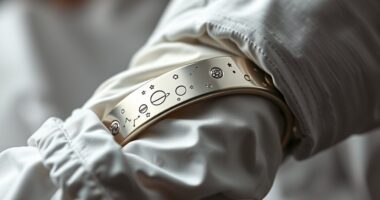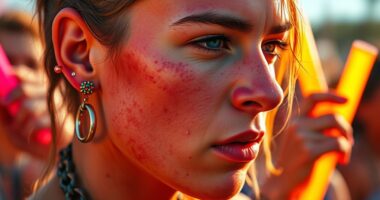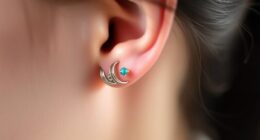Piercings in the performing arts serve as powerful tools for self-expression and identity. They enhance aesthetics in circus acts and theater performances, allowing you to challenge beauty norms and showcase individuality. As you explore characters, piercings reveal layers of personality, adding depth to storytelling. The acceptance of body modifications reflects significant cultural shifts, empowering performers and enchanting audiences. While there are safety considerations to keep in mind, these visual elements create memorable experiences. You'll discover how these trends continue to evolve, enriching the narratives and aesthetics in the world of performance.
Key Takeaways
- Piercings symbolize individuality and artistic expression, evolving from cultural rites to essential elements in circus and theater performances.
- Body modifications challenge beauty standards, allowing performers to communicate identity and enhance storytelling through visual narratives.
- Inclusive casting celebrates visible piercings, promoting diversity and reflecting broader societal shifts in self-presentation within the performing arts.
- The integration of technology, like augmented reality, amplifies the impact of piercings in performances, enhancing audience engagement and visual storytelling.
- Education and community building around body modifications foster understanding and respect, creating inclusive environments that empower diverse performers.
Historical Significance of Piercings
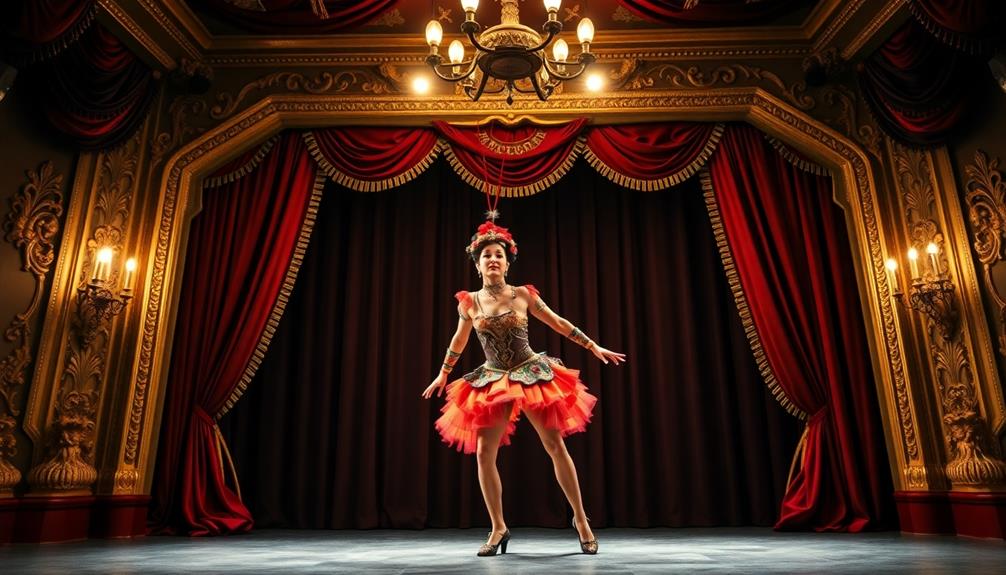
Piercings have long played a significant role in various cultures, serving as powerful symbols of rites of passage, status, beauty, and rebellion. In the context of circus arts, these body modifications historically showcased performers as curiosities, intriguing audiences with their unusual and exotic appearances.
During the Victorian era, society's fascination with the bizarre led to a unique representation of piercings, elevating them to symbols of individuality within the performance domain.
As the modern sideshow movement evolved, the perception of piercings shifted from mere entertainment to a celebration of artistic expression. Performers began to use body modifications like piercings to enhance their acts, creating striking visuals that challenged traditional beauty standards.
This transformation allowed audiences to see piercings as integral to the narrative rather than mere adornments.
Furthermore, the rise of neo-burlesque has popularized piercings in performance arts, where they serve as essential elements of self-expression and empowerment. In this vibrant scene, every piercing tells a story, contributing to the overall message and aesthetic of the performance.
You can see how piercings have woven themselves into the rich tapestry of circus and theater, marking their historical significance in the performing arts.
Artistic Expression Through Body Modifications
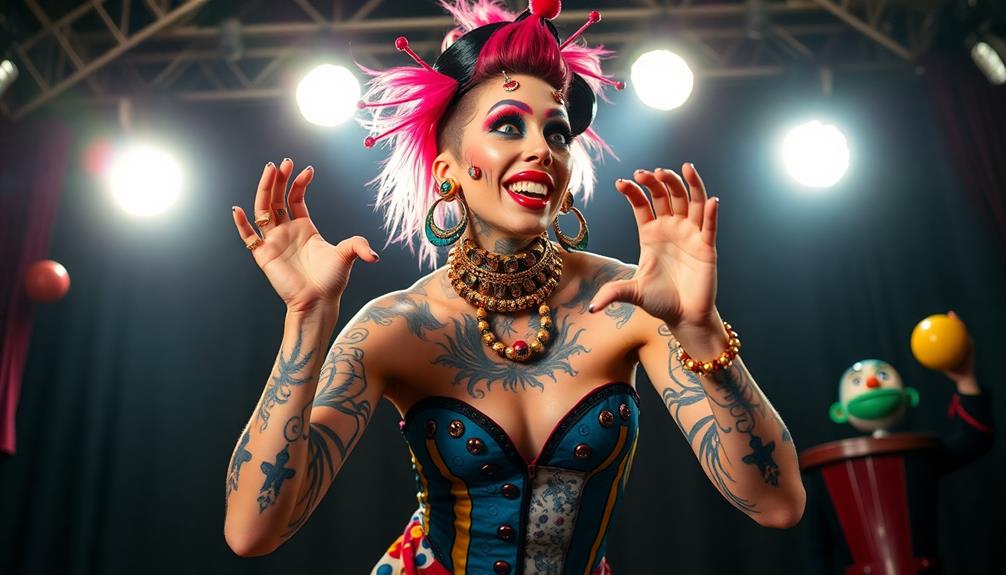
Body modifications, like piercings, serve as powerful tools for artistic expression in the performing arts. They not only enhance your performance aesthetics but also reflect cultural significance and personal identity.
Embracing these forms of body art can also encourage individuals to prioritize self-care and mindfulness in their creative journeys, as they navigate their unique artistic paths.
As you embrace these forms of body art, you challenge traditional beauty norms and celebrate diversity on stage.
Body Art as Expression
Artistic expression often finds its most unique forms through body modifications, like piercings, which allow performers to showcase their individuality and creativity. In the performing arts, body art serves as a powerful tool for self-expression, enabling artists to communicate their identity beyond traditional aesthetics.
As you observe contemporary dance and theater, you'll notice how tattooed and pierced performers embody confidence and challenge modern beauty standards.
Neo-burlesque performances, in particular, highlight body art, using piercings and tattoos to enhance visual storytelling. These modifications celebrate the human form, adding layers of meaning to performances. Specific piercings, such as Monroe piercings or microdermal implants, have gained popularity among performers, as they introduce unique visual elements that complement costumes and elevate stage presence.
The growing acceptance of body modification in the performing arts reflects a broader societal shift. It challenges conventional norms regarding beauty and self-presentation, allowing artists to express themselves authentically.
Cultural Significance of Modifications
In many performing arts circles, body modifications like piercings carry deep cultural significance, acting as a visual language that transcends spoken word. These modifications allow you, as an artist, to showcase your individuality and challenge traditional beauty norms.
In modern sideshow circus performances, piercings become integral to the act, enhancing the visual impact while promoting narratives of self-empowerment and rebellion against societal standards.
You might notice that the neo-burlesque movement embraces piercings as symbols of confidence, further blurring the lines between art and sexuality. This cultural acceptance of body modifications has transformed how society views dancers and circus performers, increasingly recognizing them as canvases of art.
Your body tells a unique story through these modifications, each piercing representing a personal narrative.
Contemporary dance has also normalized tattoos and piercings, with social media showcasing diverse representations of beauty and artistry. These platforms influence trends in performance attire, allowing your artistic expression to resonate with wider audiences.
As you engage in the performing arts, remember that your body, adorned with piercings, carries powerful cultural significance that speaks volumes about identity and acceptance.
Enhancing Performance Aesthetics
Piercings amplify the visual narrative in performance arts, allowing you to express your identity and emotions in striking ways. These body modifications serve as powerful tools for artistic expression, enhancing the overall impact of your performance.
In circus acts and contemporary dance, piercings like belly rings and microdermal implants not only complement your costumes but also create mesmerizing visual effects that draw in audiences.
By embracing piercings, you challenge traditional beauty norms and showcase a diverse range of body representation. This bold approach encourages acceptance and appreciation among viewers, fostering a deeper emotional connection during your performances.
Studies indicate that performers adorned with visible piercings often attract greater attention, enhancing engagement and interaction with the audience.
Moreover, in neo-burlesque, piercings symbolize individuality and confidence, redefining aesthetics in the performing arts. As you incorporate these elements into your acts, you contribute to a broader narrative that celebrates personal expression and body positivity.
Ultimately, piercings not only enhance your artistic presentation but also serve as a powerful statement about identity, beauty, and the transformative power of performance.
The Role of Piercings in Circus Performances
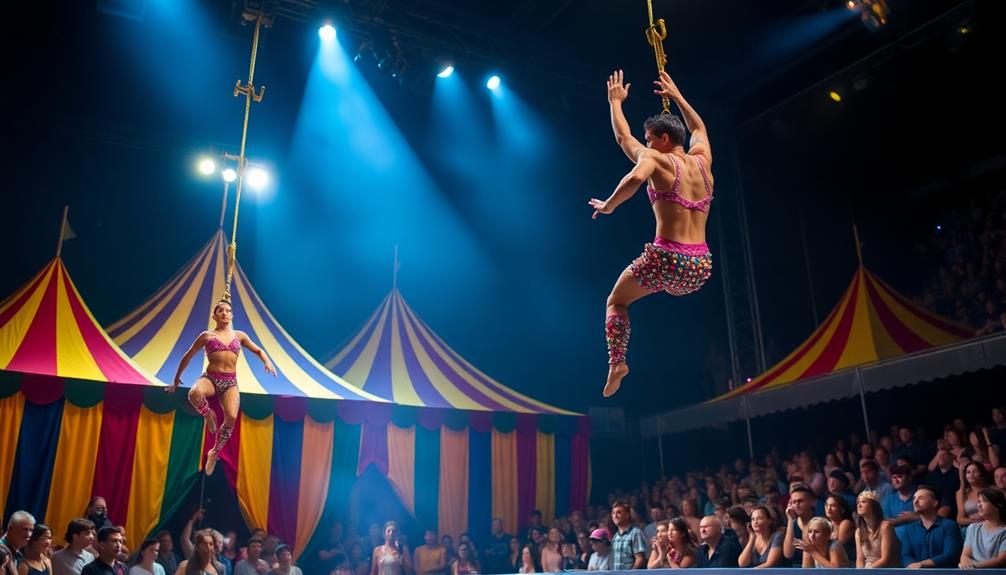
Body art plays a significant role in circus performances, where piercings enhance the visual spectacle and captivate audiences. These body modifications serve as a striking aesthetic, allowing you to express individuality while pushing the boundaries of artistic expression.
Performers often incorporate unique piercings, like vertical labrets or dermal anchors, to create memorable characters that resonate with viewers.
- Piercings highlight the skill and artistry involved in both performance and body modification.
- Many modern circuses embrace diverse forms of body art, reflecting a cultural shift toward celebrating individuality.
- Safety protocols are crucial, ensuring that performers can execute high-risk acts without compromising their health.
As you watch a circus act, you'll notice how these piercings not only amplify the performers' visual appeal but also contribute to the overall narrative of each act.
The integration of piercings into circus performances showcases an evolving art form that values both creativity and personal expression. This evolution demonstrates how the circus continues to adapt, embracing body modification as an essential part of its identity and artistry.
Piercings and Identity in Theater
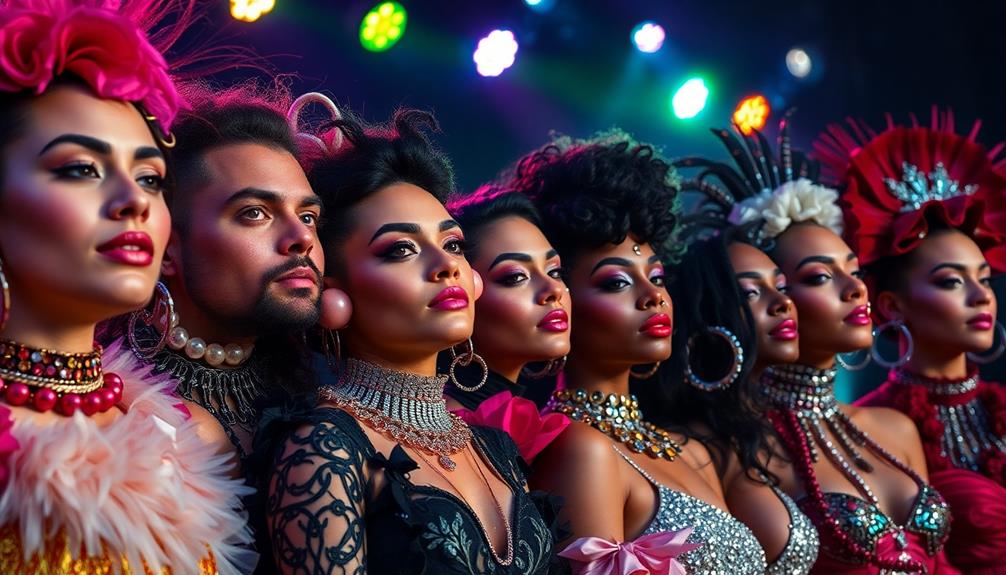
Theater often showcases how piercings shape a character's identity, revealing layers of personality and emotion. When you watch a performance, notice how piercings serve as a visual representation of a character's background and emotional state.
Contemporary theater productions embrace body modifications, including piercings, to challenge traditional beauty norms and promote individuality among performers.
By integrating piercings into costumes, productions enhance storytelling, emphasizing themes of rebellion, freedom, or societal commentary. You can see how performers with piercings create a distinct aesthetic that sets their characters apart in ensemble casts, making them more memorable and engaging for the audience.
As acceptance of piercings in theater has grown, many productions now celebrate diverse body art as an expression of cultural identity and personal empowerment.
This shift allows performers to embody their characters more fully, using piercings not just as decoration but as an essential part of their identity. In this way, piercings become a powerful tool in the theatrical toolbox, contributing to a richer, more nuanced portrayal of characters that resonate with the audience on multiple levels.
Cultural Shifts in Body Art Acceptance
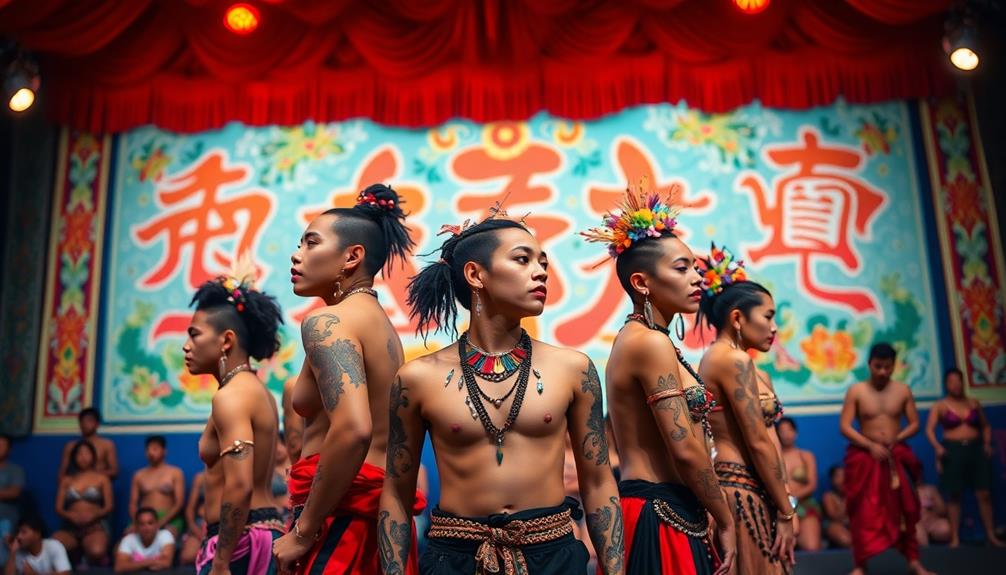
As performers increasingly embrace piercings and other forms of body art, a significant cultural shift is occurring within the performing arts.
You'll notice that contemporary dance and theater now prioritize individual expression over traditional norms of uniformity. This evolution highlights how body modifications, like piercings, have become an integral part of artistic identity.
The acceptance of diverse identities in performance art can be likened to the healing journey from toxic relationships, where building a support network fosters personal empowerment and confidence.
- Neo-burlesque performances celebrate tattooed and pierced artists, enhancing visual storytelling.
- Social media platforms amplify this shift, allowing performers to showcase their modified aesthetics and challenge conventional beauty standards.
- Research shows that body modifications can boost performers' confidence and stage presence, enriching their artistic expression.
The growing visibility of modified individuals in mainstream media reflects this cultural acceptance.
Events and festivals dedicated to body art are gaining popularity, further solidifying the idea that body modifications aren't just acceptable, but celebrated.
As you engage with the performing arts, you'll see how this shift isn't just about aesthetics; it's a movement toward embracing diverse identities and fostering a richer, more inclusive artistic community.
Risks and Safety in Body Modifications
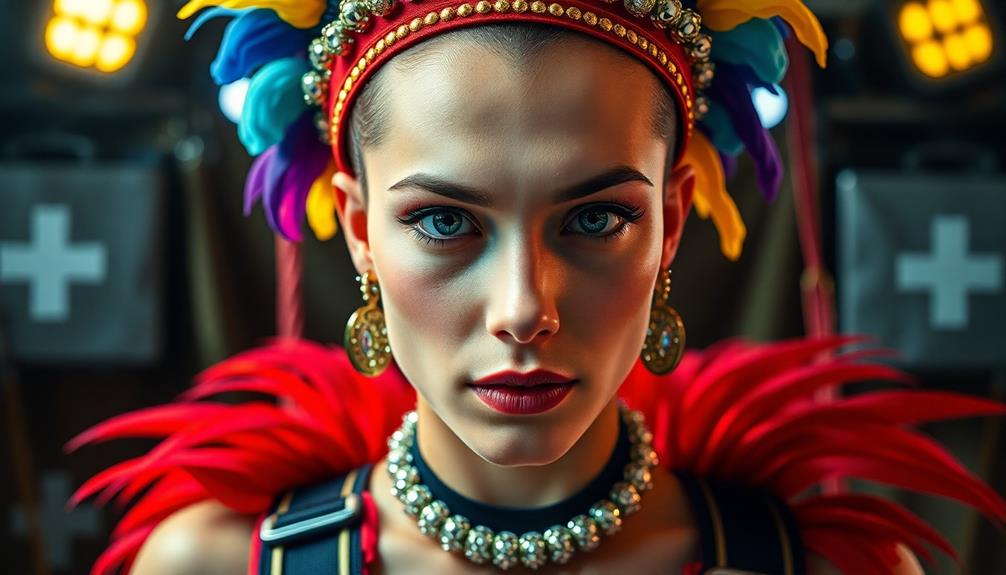
Steering through the world of body modifications, including piercings, comes with inherent risks that require careful consideration. Infections, allergic reactions to materials, and complications from improper techniques can arise, making it fundamental to seek out professional practitioners.
They understand the importance of using sterile equipment and adhering to hygiene protocols, greatly reducing the chances of complications.
The healing process for piercings can vary—typically taking 4 to 6 weeks for earlobe piercings and several months for cartilage. During this time, proper aftercare is essential to prevent infections.
You'll need to follow guidelines provided by your piercer to guarantee a safe recovery.
Additionally, legal regulations regarding body modifications can differ by location, affecting the accessibility and safety of piercing practices. It's critical to be aware of these laws before proceeding.
Lastly, consider the psychological impacts of body modifications, such as body dysmorphia or regret. Consulting with professionals before undergoing any procedures guarantees informed decision-making, contributing to your overall safety and satisfaction.
Prioritize your well-being by recognizing the risks and making educated choices in the world of body art.
Future Trends in Performing Arts
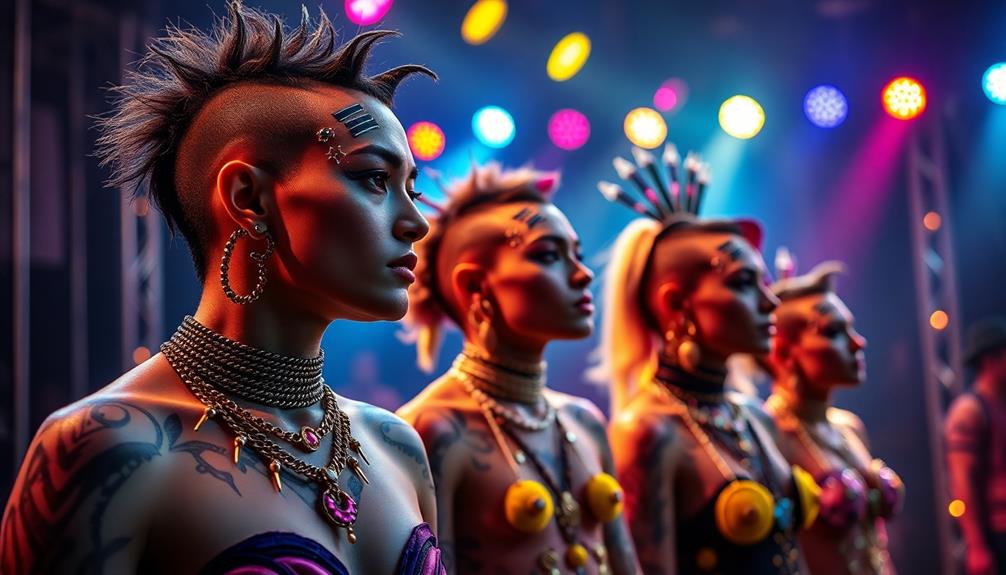
As you explore the future of performing arts, you'll notice evolving aesthetic standards that embrace unique body modifications like piercings.
Technology's integration will also play an essential role, enhancing visual storytelling and audience engagement.
Plus, inclusive performance practices are set to reshape casting and creative decisions, making room for diverse expressions of identity on stage.
Evolving Aesthetic Standards
The landscape of performing arts is transforming, with body piercings emerging as a bold statement of individuality and artistic expression. This evolution reflects a broader trend where contemporary circus and theater embrace visible piercings, celebrating the uniqueness of each performer.
Neo-burlesque and modern dance are at the forefront, using piercings to challenge traditional beauty norms. As you explore this new aesthetic, consider the impact of social media in promoting diverse body art standards. Performers now showcase their unique styles, redefining what's considered beautiful in popular culture.
With over 30% of artists integrating body modifications into their presentations, it's clear that this trend is gaining momentum.
Here are a few key points to ponder:
- Sideshows historically paved the way for body modifications in performance art.
- The rise of inclusive casting opens doors for varied aesthetics.
- These changes reflect a larger cultural shift towards acceptance and self-expression.
With rights reserved for individual artistry, the performing arts are embracing a future where piercings symbolize freedom and authenticity. This evolving aesthetic standard invites you to celebrate the diverse expressions of performers in every show.
Integration of Technology
Emerging alongside the evolving aesthetic standards in performing arts, technology is reshaping how artists express their individuality and creativity. Augmented reality (AR) and virtual reality (VR) are transforming performances by enhancing body modifications like piercings, creating immersive experiences that captivate audiences. Artists can utilize advanced projection mapping to craft dynamic backgrounds that interact with piercings, weaving a cohesive narrative throughout their acts.
Wearable technology, such as LED piercings and smart jewelry, is gaining traction, allowing performers to introduce interactive elements that respond to audience engagement or music. This innovative approach enhances the overall experience, making performances more engaging and memorable.
Data analytics plays a critical role in understanding audience reactions. By analyzing responses to body modifications, artists can tailor their acts to maximize emotional impact.
The rise of live-streaming also showcases these unique body modifications to a global audience, promoting visibility and acceptance of diverse forms of body art within the performing arts.
| Technology Type | Application in Performance | Impact on Audience Engagement |
|---|---|---|
| Augmented Reality | Visual enhancement of piercings | Immersive experiences |
| Wearable Technology | Interactive LED piercings | Real-time audience interaction |
| Data Analytics | Gauging audience reactions | Tailored emotional impact |
| Projection Mapping | Dynamic backgrounds | Cohesive narrative |
| Live-Streaming | Global showcase | Increased visibility |
Inclusive Performance Practices
Inclusive performance practices are reshaping the landscape of the performing arts by celebrating diversity and challenging traditional beauty standards. By embracing body modifications, such as piercings, these practices foster a richer representation of what it means to be a performer.
The rise of neo-burlesque and alternative theater has opened doors for individuals with diverse body types, creating spaces where everyone feels empowered and visible. Additionally, just as the tea culture emphasizes mindfulness and respect, inclusive practices encourage performers to honor their unique identities, creating a more harmonious performance environment.
This shift parallels the way brewing the perfect cup of tea requires attention to detail and a focus on quality.
Here are some key aspects of inclusive performance practices:
- Empowerment: Research shows that 75% of performers with body modifications feel more confident in inclusive environments.
- Education: Workshops are now focusing on the cultural significance of body modifications, encouraging artists to integrate these elements into their performances.
- Community: Social media plays a crucial role in connecting artists and audiences, with hashtags like #BodyPositiveTheater enhancing visibility and support.
As you explore these practices, remember that inclusive performance isn't just about representation; it's about creating a stage where everyone's unique identity shines.
Frequently Asked Questions
Does AMC Allow Facial Piercings?
AMC doesn't have a strict policy on facial piercings, but you should check with your specific location. You might need to wear retainers or cover them to maintain a neat, professional appearance while on duty.
What Do Actors Do About Piercings?
Over 60% of actors adapt their piercings for performances. You'll often see them covering or removing jewelry to fit character aesthetics, but some creatively integrate their piercings into their roles, enhancing their unique artistic expression.
What Do Piercings Symbolize?
Piercings symbolize individuality and self-expression, allowing you to showcase your unique identity. They often represent personal growth, maturity, and cultural connections, challenging traditional beauty standards while enhancing your overall visual narrative and emotional depth.
What Is the Cultural Significance of Piercings?
Piercings hold deep cultural significance, often symbolizing rites of passage, identity, and personal beliefs. They challenge beauty norms, fostering self-acceptance and empowerment while allowing you to express your unique story and individuality through body art.
Conclusion
As you step into the vibrant world of performing arts, you can't help but wonder: what stories do those piercings tell? Each glimmering piece of jewelry holds a secret, a glimpse into the identity and struggles of its wearer. The future of body art in this domain is uncertain, yet thrilling. Will these bold expressions continue to challenge norms, or will they fade into tradition? Only time will reveal the enchanting journey of piercings in the spotlight.









